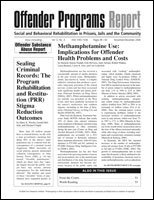Maximizing Mental Health Services for Justice-Involved Youth Using Diverse Funding
Author: Emily Luhrs .; Selena Teji.
Source: Volume 15, Number 05, January/February 2012 , pp.65-68(4)

< previous article |next article > |return to table of contents
Abstract:
Two thirds of youth nationwide suffer from lack of mental health treatment and when examined through the lens of juvenile justice, this number is more substantial. Since the 1980s, juvenile justice systems have, in effect, replaced public psychiatric hospitals in the care of mentally ill youth; even though the system lacks the resources to provide adequate services for this population. The population of justice-involved youth with identified mental health needs, known as the “crossover caseload,” has increased in recent years, as has the severity of their needs. The authors argue that In order to provide outcomes-based treatment specific to this population, counties need to reduce their reliance on categorical funding streams that restrict investment in innovative and community-based services and instead seek out diverse funding streams.Keywords: funding streams; youth
Affiliations:
1: Center on Juvenile and Criminal Justice; 2: Center on Juvenile and Criminal Justice.